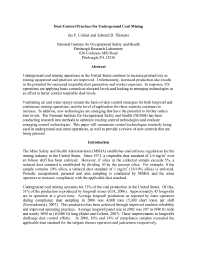Mining Publication: Dust Control Practices for Underground Coal Mining
Original creation date: September 2007
Underground coal mining operations in the United States continue to increase productivity as mining equipment and practices are improved. Unfortunately, increased production also results in the potential for increased respirable dust generation and worker exposure. In response, US operations are applying basic controls at elevated levels and looking to emerging technologies in an effort to better control respirable dust levels. Ventilating air and water sprays remain the basis of dust control strategies for both longwall and continuous mining operations, and the level of application for these controls continues to increase. In addition, new technologies are emerging that have the potential to further reduce dust levels. The National Institute for Occupational Safety and Health (NIOSH) has been conducting research into methods to optimize existing control technologies and evaluate emerging control technologies. This paper will summarize control technologies routinely being used in underground coal mine operations, as well as provide a review of new controls that are being pursued.
Authors: JF Colinet, ED Thimons
Conference Paper - September 2007
NIOSHTIC2 Number: 20032688
In: Proceedings of the 32nd International Conference of Safety in Mines Research Institutes, 28-29 September 2007, Beijing, China. Beijing, China: National Center for International Exchange & Cooperation on Work Safety (SAWS), 2007; :332-338
See Also
- Best Practices for Controlling Respirable Dust in Coal Mines
- Dust Underfoot: Enclosed Cab Floor Heaters Can Significantly Increase Operator's Respirable Dust Exposure
- The Effects of Water Spray Placement for Controlling Respirable Dust and Face Methane Concentrations
- Equivalency of a Personal Dust Monitor to the Current United States Coal Mine Respirable Dust Sampler
- Evaluation of the Approach to Respirable Quartz Exposure Control in U.S. Coal Mines
- Improved Drill Shroud Capture of Respirable Dust Utilizing Air Nozzles Underneath the Drill Deck
- Improving Silica Dust Control Through Targeted Research
- Laboratory Testing To Quantify Dust Entrainment During Shield Advance
- Respirable Quartz Hazard Associated with Coal Mine Roof Bolter Dust
- Technology News 447 - Dust Collector Discharge Shroud Reduces Dust Exposure to Drill Operators at Surface Coal Mines
- Page last reviewed: 9/21/2012
- Page last updated: 9/21/2012
- Content source: National Institute for Occupational Safety and Health, Mining Program


 ShareCompartir
ShareCompartir
